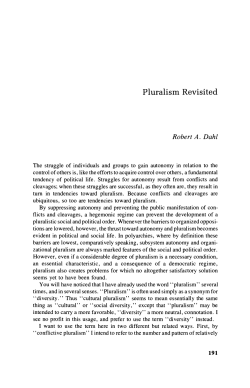
Presentación de PowerPoint
Monitoring of Pluralisms 41st EPRA Meeting Berne, 15th May 2015 Law 2/2000, of May 4th on the Catalan Audiovisual Council Catalan Parliament (Resolution 341/VI-2000) • “To make sure that the regulations governing audiovisual content are complied with, in particular the principles of political, social, religious, cultural and philosophical pluralism” (article 10) • “[…] report on the informative pluralism in public media, TV and radio, of Catalonia […]” Monitoring of Pluralism: a legal duty of the CAC A definition of internal pluralism was formulated: “Internal pluralism is the proximity between the media representation of reality and social reality” Internal pluralism: definition Independent source of data • The CAC provides independent data of media presence in a stable theoretical framework Improvement • This framework allows the CAC to monitor the media so that they improve and foster the respect of pluralisms Pluralisms: why? Hardware and software Specific cataloguing Human resources Analysis How? [Tarsys] 5 Cataloguers 4 Analysts Contents Area Human resources What do news programmes inform about? Who (and during how long) speaks in daily news programmes? Who (and how often) takes part in debates or is interviewed (in daily news programmes and magazines) Methodology: research questions Screen time Speaking time Frequency of appearance Methodology: variables Reports on pluralism Monthly reports Political Pluralism Elections Complaints Social Pluralism Reports on pluralism Kind of programmes • Daily news programmes • Magazins What channels? • 4 TV stations: 2 public TVs (the catalan one and the programmes broadcasted only for Catalonia by the spanish public television) and 2 catalan private TVs • 2 radio stations: the catalan public radio and the main private station. Structure of the report • Quantitative data • Speaking time in daily news programmes • Politicians appeared in debates and interviews • Analysis of data Monthly reports on political pluralism Screen time of a piece of news or of a cluster of news Speaking time of politicians Speaking time of politicians related to every piece of news or cluster of news Speaking time of political groups (parties and institutions) Politicians interviewed or taking part in a debate Gender pluralism related to politicians Quantitative data Information context of the month The media presence of parliamentary and non-parliamentary political parties The presence of governments (Catalan, Spanish and local city halls). Information about Catalan Parliament. Gender of politicians on the screen Analysis of data Election campaigns • Special and deeper monitoring during election campaigns: • One report every day • Monitoring of screen time by candidacy • Analysis of the verbal content of the pieces of news related to elections Complaints: analysis ad hoc Other political pluralism reports Culture Gender Age groups Disability Origin Social role Non-political pluralism Does television show a diverse society? Diversity and Equality Does each TV format treat diversity and equality in a different manner? Does television show an egalitarian society? Objective: answering 3 questions Type of programmes Variables Sample • Fiction • Non-fiction • • • • • Sex Age Origin Disabilities Social roles • 400 characters on fiction (aprox.) • 8.000 interventions in news programmes • 4.400 interviewees or participants in debates Methodology Knowledge Catalan society and what media reflects Monitoring and analysis of media Reality To conclude Of media to improve society Improvement Governments and political parties Speaking time: Governments 51,4% Parties 48,6% Interviews (time): Governments 36,3% Parties 63,7% Presence of parlamentary parties Every party in Catalan Parliament and every group in Spanish Parliament has speaking time relative to their representation in both Parliaments To conclude: political pluralism Presence of economic/labour associations Interviews: Trade Unions: 47,5% increase Business associations: 85,9% increase (from 2011 to 2013) Presence of women Womenpolitical party Inserts: 23,2% (2011) to 25,8% (2013) Interviews: 15,4% (2011) to 20,5% (2013) To conclude: Improving Women have increased from a 5% (2004) to a 26,6% (2012) of total (men and women) Thank you for your attention Our reports are available at www.cac.cat
© Copyright 2025









